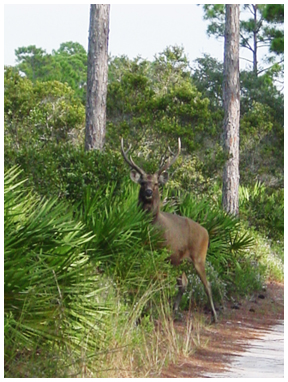
This fall, Northwest Florida offers some special deer and wild hog hunts at St. Marks National Wildlife Refuge (NWR) and a unique “big-game” sambar deer hunt on the island of St. Vincent NWR.
The application period for these hunts begins at 10 a.m. May 3 and continues through 11:59 p.m. June 9.
There are two archery hunts, two general gun hunts and one mobility-impaired gun hunt on St. Marks NWR, which covers 60,000 acres in Wakulla, Jefferson and Taylor counties. Five-day archery hunts for white-tailed deer and wild hogs are Nov. 8-12 in the Panacea Unit and Nov. 1-5 in the Wakulla Unit. There are 200 available permits for each hunt at $15 each.
The two general gun hunts are both three days long and take place on the area’s two units: Wakulla (Dec. 9-11) and Panacea (Dec. 16-18). There are 150 permits available for the Wakulla Unit and 80 for the Panacea Unit. These permits cost $15, if you are drawn.
The three-day mobility-impaired gun hunt is for hunters certified as mobility-impaired by the FWC. It is on the Panacea Unit Dec. 10-12, and 15 permits are available – again, $15 if drawn.
For hunters looking to rough it a bit more and go after some truly big game, the 12,490-acre, undeveloped barrier island of St. Vincent NWR in Franklin County is where the hunt’s on for the enormous, imported sambar deer. These reddish-brown deer, which are actually in the elk family, are native to Southeast Asia and were introduced on the island in 1908. They can measure 6 feet tall at the shoulder and weigh more than 700 pounds.
You also can harvest wild hogs on this hunt, but it must be with bows or muzzleloaders. Hunters with a Disabled Crossbow Permit may use crossbows.
The primitive-weapon sambar deer/wild hog hunt is Dec. 1-3, and there are 200 permits available, costing $25. Hunters who purchased this hunt last year aren’t eligible to apply this year.
The bag limit on sambars is two (male or female), and there is no bag limit on hogs.
You can get to St. Vincent Island only by boat. If you don’t have one, you can contact the local chamber of commerce for a list of boat captains who will ferry you to and from the island for a fee.
The island has no electricity, and generators are not allowed, so it’s all about primitive camping for three days. Hunters may have a small campfire, but only using wood they take with them or deadwood they find on the ground.
Take a bicycle, unless you plan to walk everywhere. If you do harvest any game, however, U.S. Fish and Wildlife Service staff will pick up you and your animal in one of their trucks. That’s the only way you’re catching a ride in a motorized vehicle, unless you’re a hunter with a disability. Those hunters receive special accommodations and transportation to and from their hunting spots.
Sambars feed on aquatic vegetation, so you’re not likely to find them in drier, upland habitat. It’s best to set up in marshes.
Shooting hours for this hunt end at 3 p.m. each day.
All of the above-mentioned hunt permits are nontransferable. An adult must accompany permit-holders under age 16 on all of these hunts, but that person may not hunt unless they too have purchased a permit. Mobility-impaired hunters can bring one guest who may hunt, but both hunters must share a single bag limit. Only permitted hunters or the adult supervisor of a permitted youth are allowed access to St. Vincent Island during the sambar deer hunt.
Up to five hunters can choose to apply as a group. To apply as a group, one person must first apply as group leader, indicate the creation of a group and enter the hunt choice for the group. The group leader receives a group number (printed on receipt), which group members need. Each group member must then submit a $5 application and indicate the group number.
You can apply for these permits online at www.fl.wildlifelicense.com (choose “Limited Entry/Quota Permits and Applications”) or complete an application worksheet and present it to any license agent or tax collector’s office by 11:59 p.m. June 9. Permit information and application worksheets are available online at MyFWC.com/Hunting (click on “Limited Entry Hunts”).
The FWC issues these permits by a random drawing that takes place in late June. The application fee is $5. You can check the results of the drawings online at MyFWC.com/Hunting; click on “Limited Entry Hunts” and look for the link “Drawing Results.”
